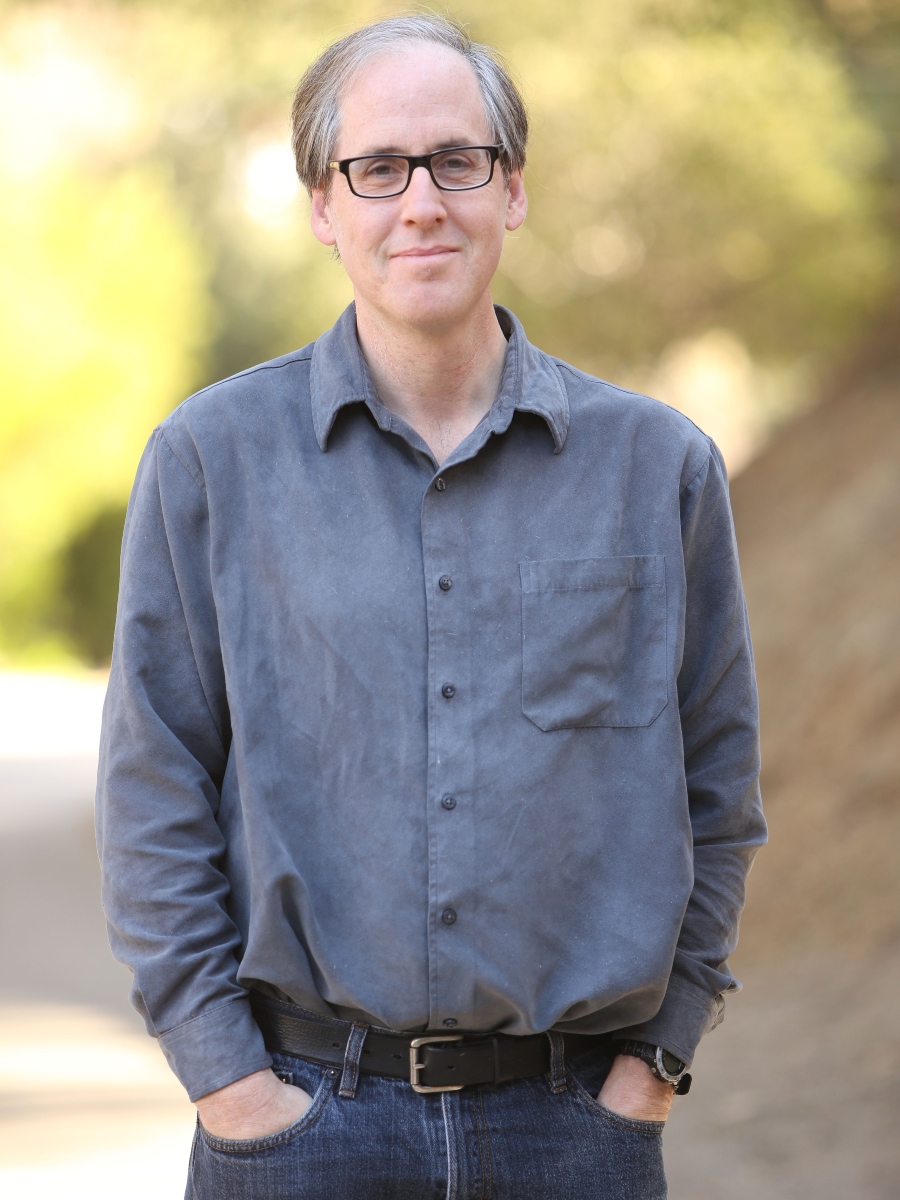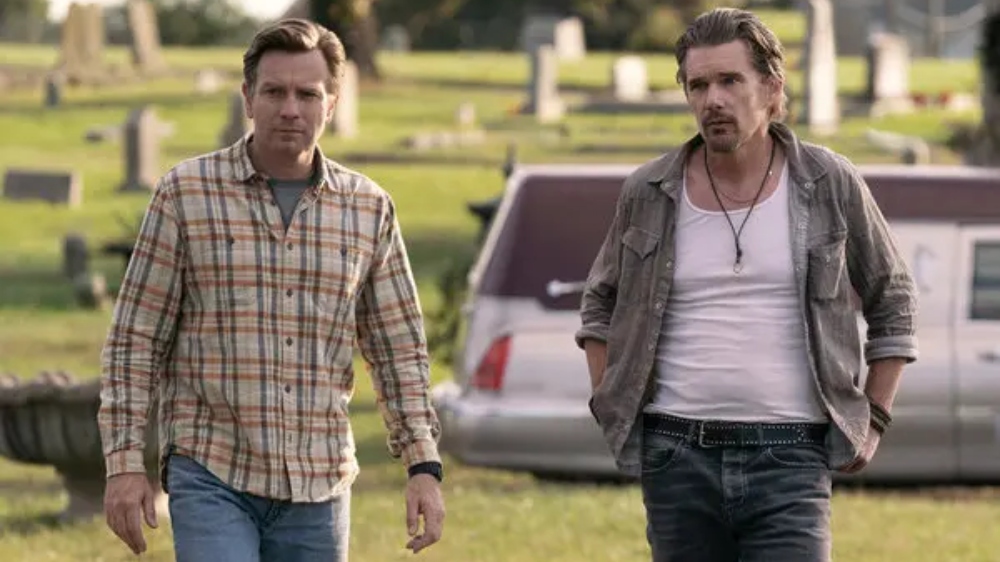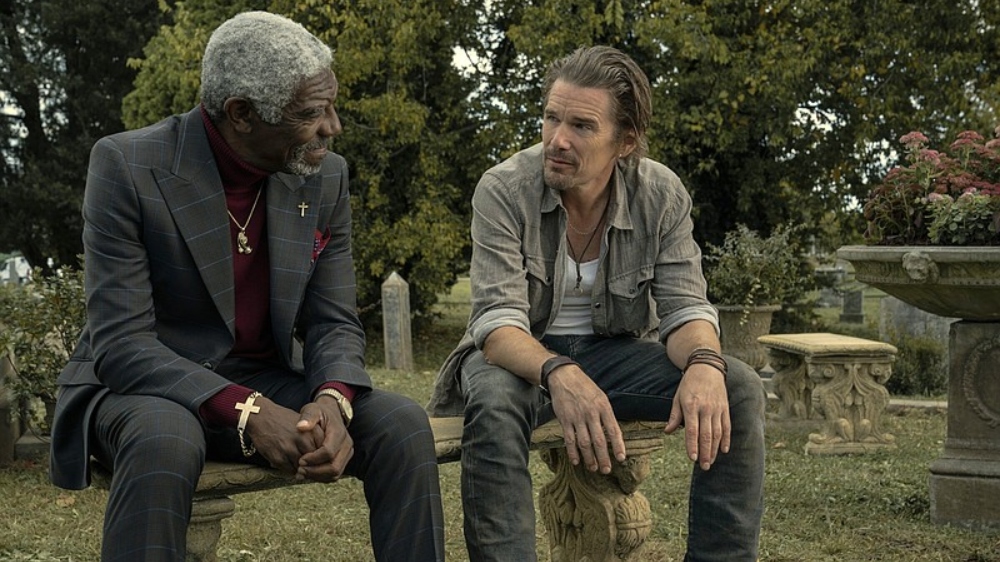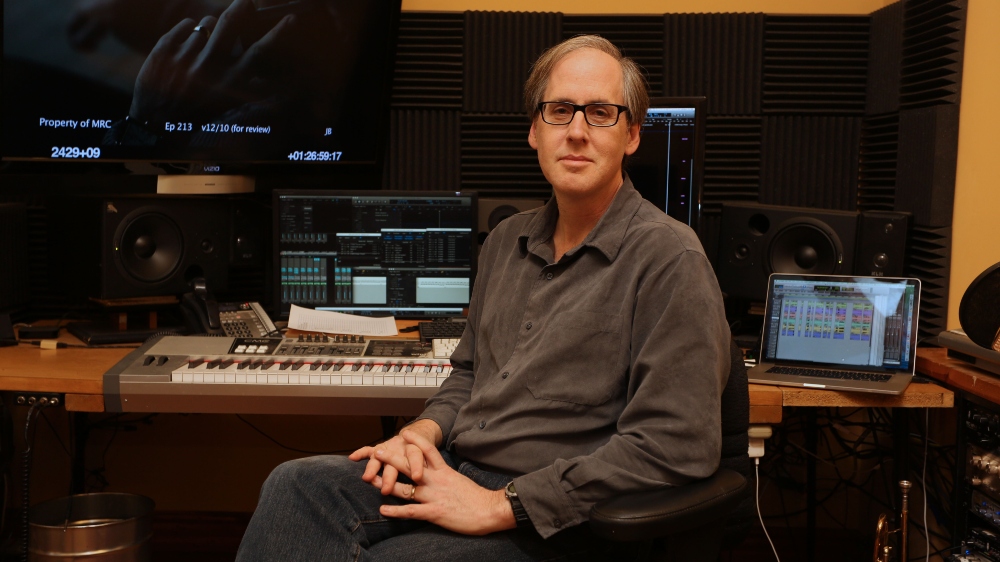Jeff Beal is already a five-time Emmy Award winner, and the composer’s score for the Apple TV+ movie Raymond & Ray –which spans from jaunty and jazzy to heartbreaking — could have him in the hunt for another statue.
A trumpet player since his youth, Beal seemed particularly suited to Raymond & Ray, as Ethan Hawke‘s character, Ray, is a trumpet player who reluctantly reconnects with his estranged brother, Raymond (Ewan McGregor), following the death of their father. It also helped that Beal had previously collaborated with the film’s Writer-Director, Rodrigo Garcia, on the HBO series Carnivale — just one of his TV credits, which also include House of Cards, Monk, and The Newsroom. Additionally, Beal has scored a handful of notable documentaries, such as Blackfish, Weiner, The Queen of Versailles, and JFK Revisited.
Below the Line recently caught up with Beal, who discussed his earliest connections with music, his thoughts on how a score should complement an actor’s performance, and how he collaborated with both Garcia and Hawke on the music for Raymond & Ray before teasing some of his upcoming projects.

Below the Line: What kind of music did you grow up surrounded by as a kid?
Jeff Beal: I grew up in the San Francisco Bay area in the ’70s. I was born in ’63. I grew up in the East Bay. We had Tower of Power and all the jazz clubs in San Francisco. We had the San Francisco Symphony, and I played in the Oakland Youth Symphony. My parents were music lovers. I grew up in a Presbyterian Church, so there were hymns. They loved what I’d call “the American Songbook.” My mom was a pianist. She had on the piano several books of old standards from the American Songbook; those would often be played and sung. There was a lot of singing around the house. My grandmother on my dad’s side, Irene, was a huge jazz fan. When I started playing trumpet in middle school, she went into her little stack of LPs on her piano and pulled out two records that she gave to me. One was a vinyl Miles Davis, Sketches of Spain, and the other one was Kind of Blue. That’s just a smattering.
Of course, being a trumpet player, I grew up with great public music programs in California, in Castro Valley. I played in the orchestra and the jazz band. Through those worlds, by the time I was playing in the Oakland Youth Symphony, for example, I heard Stravinsky‘s “The Rite of Spring.” That was when my brain just exploded, because that music, even though it wasn’t a film score, was an incredible piece of symphonic music. It’s actually in ballet, but it told the story in a way that I’d never heard any other composers tell the story. I said to myself, ‘This is what I want to try to do with my life.’
BTL: How easily did the shift come when you started doing film and television scores?
Beal: I’d call it organic and enjoyable. In my 20s, I was more along the jazz trumpet player track. I did several solo records for Island Records and Tri Loca. I was writing for other people’s albums. When I started to have the opportunity to write for film, I had moved to L.A. and was in my 30s. It was so much fun because, unlike being a solo artist, where you’re expected to stay in a general zone and genre, every film was different. I was like a kid in a candy store because I have eclectic taste. I don’t like to put any sort of false silos in musical styles. If it’s great, it’s great, whether it’s hip-hop, jazz, or classical. The idea of having this smorgasbord of different styles I could tap into, of other composers who I loved — whether it was Nino Rota on one side or Mark Isham on the other side, or electronic music, all these different things — I felt it was very liberating and fun.

BTL: Some scores are lead characters, some are supporting actors that complement the leads, and some scores are subtle and meant to be background players. If you’ll indulge that analogy, what’s your philosophy about music and how it’s deployed in films and TV shows?
Beal: All of the above can be extremely valuable. The important thing for the composer is to know what role the scene is asking of you. Early in my career, I did a film for Ed Harris called Pollock that sort of broke it open for me. It’s a pretty subtle drama, but it had two big montages where Ed’s character, Jackson Pollock, paints a mural and there is basically no other sound except for music. As a composer, we all love to serve as background artists or as another actor in the room, in a way, to support the work of the actors. Not trying to usurp a performance, but to gently frame it.
When I first moved to Los Angeles as a young guy, I went and heard Henry Mancini speak at a panel at the Motion Picture Academy. He showed a clip from The Pink Panther, [it was] the theme to Pink Panther, which is just great and quintessential, and he said something that never went out of my head. He goes, ’90 percent of the time, as film composers, our job is to stay in the background to support the drama. We can do it very artfully and hopefully with great music, but not come to the forefront of the audience’s imagination. Every once in a while, you get your shot. It’s your pitch, where everybody’s going to be paying attention to your music. When that pitch comes, make sure you swing for the fences.’ That’s what we try to do.
BTL: How does a project generally come to you?
Beal: I’m 59, and I’ve been doing this [for] a while. A lot of people know my work and have worked with me. I’ve been lucky to have past collaborators come back. Raymond & Ray was very much that type of project. Rodrigo and I had worked together years ago on Carnivale. He had heard a jazz trumpet score I did for a film called The Passion of Ayn Rand that he was in love with. Finally, a script showed up in my inbox with this jazz trumpet player character.
Ed Harris is another great example because he’s a wonderful actor, but he’s also a director. I did Ed’s first movie, and we really hit it off. He brought me on for Appaloosa. I wish he did more movies, but he’s Ed Harris. He’s always got another gig going in front of the camera, too. I have several directors that I work with, especially in the documentary space. I’ve done a lot of work with Lauren Greenfield, Jessica Yu… several other people.

BTL: You mentioned working several times with Ed Harris. You’ve worked with Tom Selleck a handful of times as well. Do you find yourself creating recurring themes for actors when you’ve worked with them more than once? Or is it all about the role and the scene?
Beal: That’s an interesting question, because actors have a personality. Their work is distinctive, hopefully, but they definitely have a brand and a style. An actor/director is a very specific type of creative brief. It’s a very specific type of relationship. It’s one of the things that happens with those people. I was lucky enough to work with Al Pacino on a film that he directed, Salome, which had Jessica Chastain in it. Those types of artists, I love to work with them multiple times because part of getting that shorthand is fascinating. It’s about them as filmmakers, but it’s also about them as performers.
BTL: Let’s talk about Raymond & Ray. What did Rodrigo Garcia first say to you when he reached out about the film?
Beal: One thing he said, which I really loved, is, ‘This film… nothing’s polished. This is a film about a gritty relationship, messy lives, and messy backstories.’ He wanted to make sure the music didn’t feel too perfect or like everything was slick — as he described it, “slick in Hollywood.” I liked that. We went with it and decided that Ethan’s character would be a jazz trumpet player, which was a thrill for me as that’s my instrument. Obviously, that’s why he sent me the script.
Aside from that, part of what we were trying to figure out was how to deliver the tone in Rodrigo’s script. It’s moving on one level, but also quirky and hopefully funny for people [who] have a sense of humor about death. This film is almost like a Rorschach test [of] how people feel about the death of a parent or a loved one. The dad that dies was not the perfect father at all, [but] he was still their dad. So, there’s baggage there. Rodrigo gave me some clues on that.
Also useful was, I created the trumpet piece that Ethan plays months before he started filming. That was so fun because it was detailed, what [Rodrigo] had written about the solo Ethan plays at his father’s grave. He starts [with] this little tune, then it morphs into anger, and it finally mellows. It was a real musical brief, but it was supposed to sound a little off the cuff, like maybe he made it up [on the spot]. It was fun because it was the first music I recorded here in my new studio in New York. I sent him a few things. We went back and forth several times, fine-tuning. It was a chance for us to have a dialogue with music and talk to each other about how to start crafting this.

BTL: How did COVID-19 protocols impact recording the music?
Beal: I visited the set the day Ethan was performing his stuff, which was fun. If it wasn’t for COVID, I probably would have had a little more time with Ethan, privately coaching him, but because it was COVID and they were shooting a movie, I basically did a video of his parts and sent it to him so he could learn them. In terms of realizing my score, there was some geography involved [given the] musicians I wanted to work with. My favorite jazz bassist is here in New York, John Petrucci, so I recorded him here. I recorded my piano here because my piano is downstairs. Luckily, by the time we got to that stage (of post-production) in L.A., we were able to test everybody and I was able to conduct the orchestra in the room together, which was great. Then, Peter Erskine, a fabulous jazz drummer, came in to do the jazz drums. It was a little bit multitracked at times, although it’s made to sound like it’s happening in a room [all] at one time.
BTL: What else are you working on?
Beal: A few things. I’m scoring a wonderful film that Frank Marshall is directing about the journalist Dan Rather. It’s a documentary. I’m writing a violin concerto for this amazing violinist, Kelly Hall-Tompkins, that we’re going to do with the St. Louis Symphony in 2024. This concert music is on a totally different timescale. There are a couple other things I can’t talk about yet, but I’m playing my jazz trumpet some more, which is fun. I’m conducting. I’m in the early stages of developing a series of new scores for silent films. I’ve done two already. I did F.W. Murnau’s Sunrise with L.A. Master Chorale at Disney Hall in 2020, right before COVID.
During COVID, I composed a big band score for The Cabinet of Dr. Caligari, which was just performed in Germany. I hope to bring it to the U.S. sometime. I guess it’s a trilogy, or so my manager told me. The third is going to be the silent classic Metropolis. I’m working with some orchestras in Europe, and hopefully some American partners. I’m still writing a lot of film music, and I love it, but I also love making music in person with humans. I love conducting, and the concert hall. There’s a lot happening.
Speaking of silent movies, when I was doing my first score for The General with Buster Keaton — I learned this after she’d already passed — but my grandmother was a wonderful jazz pianist and improviser, [and] she played piano for silent movies. When I learned that about her, everything clicked into place, like, ‘Okay, there’s something in my DNA.’ When you look at the way contemporary film composers work, that’s what we’re doing. We’re sitting at the keyboard and we’re looking at the screen. It’s so ironic how much it is like the old silent movie player.
Raymond & Ray is now streaming on Apple TV+.





